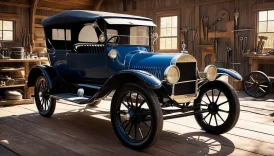Who Inspired the Legacy of Nissan?

- Who Inspired the Legacy of Nissan?
- The Founding Visionaries
- Pioneering Technology and Innovation
- The Role of Masujiro Hashimoto
- Hashimoto's Early Challenges
- Influence on Company Culture
- Shifting Towards Sustainability
- Global Expansion and Market Influence
- Key Partnerships and Alliances
- Adapting to Market Trends
- Frequently Asked Questions
The story of Nissan is not just about cars; it’s about a vision that transcended borders and time. From its humble beginnings to becoming a global automotive giant, the legacy of Nissan is deeply intertwined with the lives and dreams of its founders and leaders. Understanding who inspired this legacy provides insight into the heart of Nissan’s innovation and commitment to excellence.
Nissan was founded in 1933, but its roots stretch back even further, to a time when the automotive industry was just beginning to take shape. The brand’s inception was inspired by a group of visionaries who saw the potential for a new kind of automobile that could cater to the needs of everyday people. These pioneers, including Masujiro Hashimoto, not only dreamt of creating vehicles but also aimed to revolutionize the way people experienced mobility.
Hashimoto’s journey was not without its challenges. He faced numerous hurdles, from financial constraints to technological limitations. However, his relentless spirit and innovative mindset allowed him to navigate these obstacles successfully. Hashimoto believed in the power of collaboration and instilled this value within the company culture, fostering an environment where creativity could flourish.
To illustrate the impact of these early leaders, consider the following table that highlights key figures and their contributions:
| Founder | Contribution |
|---|---|
| Masujiro Hashimoto | Established the vision for Nissan and emphasized innovation. |
| Yoshisuke Aikawa | Played a crucial role in merging companies to form Nissan. |
As the automotive landscape evolved, Nissan continued to adapt, driven by a commitment to sustainability and technological advancement. The company has championed environmentally friendly practices, positioning itself as a leader in the quest for greener transportation solutions. This shift towards sustainability is a testament to the lasting influence of its founders, who believed that progress should not come at the expense of the planet.
In conclusion, the legacy of Nissan is a rich tapestry woven from the aspirations of its founders and the relentless pursuit of innovation. Each leader, from Hashimoto to modern executives, has contributed to a culture of excellence that continues to inspire the automotive industry today. As we look to the future, it’s clear that the spirit of these pioneers will guide Nissan in its journey ahead.
The Founding Visionaries
The story of Nissan is not just about cars; it’s about the visionaries who dared to dream big and paved the way for what the company is today. At the heart of Nissan’s inception is a group of passionate individuals who combined their talents, dreams, and sheer determination. These founders were not only motivated by the desire to create automobiles but also by a vision to transform the automotive landscape in Japan and beyond.
One of the most notable figures in Nissan’s history is Masujiro Hashimoto, whose leadership and innovative spirit were crucial in establishing the company. Hashimoto was not merely a businessman; he was a pioneer who faced numerous challenges head-on. His early experiences in the automotive industry fueled his ambition to create a brand that would resonate with people worldwide. For Hashimoto, the journey was fraught with obstacles, yet his resilience set the tone for Nissan’s corporate ethos.
| Visionary | Contribution | Impact |
|---|---|---|
| Masujiro Hashimoto | Founded Nissan Motor Co. | Laid the foundation for innovation and growth |
| Kenjiro Takeda | Developed early car models | Set standards for quality and performance |
| Yasuhiko Kato | Introduced modern design concepts | Enhanced brand appeal and market reach |
Hashimoto’s early challenges included securing funding and navigating the complex landscape of the automotive industry. Yet, he remained undeterred, continuously seeking innovative solutions and inspiring his team to embrace creativity. His ability to adapt and innovate became a hallmark of Nissan’s corporate culture, fostering an environment where new ideas could flourish.
Moreover, Hashimoto instilled a strong sense of values within the company. His principles emphasized collaboration, integrity, and a commitment to excellence. These values not only shaped Nissan’s internal culture but also resonated with customers, creating a loyal following that has persisted through decades. Today, Nissan stands as a testament to the enduring legacy of its founding visionaries, who transformed a simple dream into a global automotive powerhouse.
Pioneering Technology and Innovation
Nissan has always been at the forefront of automotive technology, pushing the boundaries of what’s possible in the industry. The company’s commitment to innovation has not only set it apart from competitors but has also paved the way for groundbreaking advancements that have transformed the way we think about vehicles. From electric cars to autonomous driving technology, Nissan’s journey is a testament to the power of visionary leadership and relentless pursuit of excellence.
One of the most significant milestones in Nissan’s history is the launch of the Nissan Leaf, which became one of the world’s best-selling electric vehicles. This achievement is not just about selling cars; it’s about leading a revolution in sustainable transportation. The Leaf’s success has inspired other manufacturers to invest in electric technology, showcasing Nissan’s role as a pioneer in the industry.
Furthermore, Nissan’s innovative spirit is reflected in its advanced manufacturing techniques and smart technologies. The company has embraced the Internet of Things (IoT) and artificial intelligence (AI) to enhance vehicle performance and customer experience. For instance, the use of ProPILOT Assist technology demonstrates Nissan’s commitment to safety and convenience, allowing drivers to enjoy a more relaxed driving experience.
To give you a clearer picture of Nissan’s technological advancements, here’s a table summarizing some of their key innovations:
| Innovation | Description | Impact |
|---|---|---|
| Nissan Leaf | World’s best-selling electric vehicle | Promoted sustainable transportation |
| ProPILOT Assist | Advanced driver-assistance system | Enhanced safety and convenience |
| Nissan Intelligent Mobility | Integration of AI and IoT in vehicles | Improved performance and customer experience |
In conclusion, Nissan’s dedication to pioneering technology and innovation has not only shaped its own future but has also influenced the entire automotive landscape. By constantly pushing the envelope and embracing new ideas, Nissan has inspired countless other brands to follow suit. As we look to the future, one can only wonder what groundbreaking innovations Nissan will unveil next!
The Role of Masujiro Hashimoto
When we talk about Nissan, one name that stands out is Masujiro Hashimoto. This visionary played a pivotal role in laying the foundation for what would become one of the world’s leading automotive brands. Hashimoto wasn’t just a businessman; he was a dreamer who saw the potential of the automobile industry in Japan at a time when it was still in its infancy. His unwavering belief in innovation and quality set the stage for Nissan’s future successes.
Hashimoto’s journey wasn’t without its hurdles. In the early days, he faced numerous challenges, from financial constraints to skepticism about the viability of manufacturing cars in Japan. However, his determination was like a fuel that kept the engine of Nissan running. He famously said, “Success is not just about having a vision; it’s about the courage to pursue it.” This mindset helped him navigate through difficult times and ultimately led to the establishment of Nissan as a household name.
| Challenges Faced | Solutions Implemented |
|---|---|
| Financial Constraints | Secured partnerships and investments |
| Technological Limitations | Invested in research and development |
| Market Skepticism | Focused on quality and customer satisfaction |
Beyond overcoming obstacles, Hashimoto’s influence extended deeply into Nissan’s corporate culture. He instilled values of creativity and collaboration among his team, fostering an environment where innovative ideas could flourish. This culture of teamwork has become a cornerstone of Nissan’s operations, enabling the company to adapt and thrive in an ever-changing automotive landscape.
In conclusion, Masujiro Hashimoto’s legacy is not just about the cars Nissan produces; it’s about the spirit of innovation and the commitment to excellence that he instilled within the company. His journey reminds us that with vision and perseverance, even the most daunting challenges can be transformed into stepping stones toward greatness.
Hashimoto’s Early Challenges
Masujiro Hashimoto, the visionary behind Nissan, faced a myriad of challenges during the company’s formative years. His journey was akin to navigating a ship through stormy seas, where each wave represented a new obstacle. Initially, Hashimoto encountered significant financial constraints that threatened to sink his ambitious plans. The automotive industry was still in its infancy in Japan, and resources were scarce.
One of the critical hurdles was sourcing the necessary materials and technology to manufacture vehicles. In the early 20th century, Japan was not yet a global player in the automobile sector, and importing technology was both costly and complicated. Hashimoto had to be resourceful, often relying on local craftsmen and engineers to innovate solutions that would keep the company afloat.
Moreover, Hashimoto faced skepticism from investors and the public alike. Many doubted whether a Japanese company could compete with established Western automotive giants. To combat this, he emphasized quality and reliability, which became the cornerstone of Nissan’s brand identity. His relentless pursuit of excellence led to the development of the first Nissan car, the Datsun Type 15, which was a turning point for the company.
| Challenge | Hashimoto’s Response |
|---|---|
| Financial Constraints | Secured local investments and minimized costs through innovative manufacturing. |
| Technological Limitations | Collaborated with local engineers and craftsmen to develop unique solutions. |
| Public Skepticism | Focused on quality and reliability to build trust in the brand. |
Hashimoto’s journey wasn’t just about overcoming obstacles; it was also about fostering a culture of innovation and resilience within Nissan. He understood that a company’s success is not merely defined by its products but also by its people. His leadership encouraged collaboration, creativity, and a shared vision, which became integral to Nissan’s identity.
In conclusion, Hashimoto’s early challenges were not just setbacks; they were stepping stones that shaped Nissan into the automotive powerhouse it is today. His story reminds us that with determination and a clear vision, even the most daunting challenges can lead to remarkable achievements.
Influence on Company Culture
Nissan’s company culture is a vibrant tapestry woven from the values and principles instilled by its founder, Masujiro Hashimoto. His vision was not just about building cars; it was about creating a community where innovation and collaboration could flourish. Hashimoto believed in empowering his employees, fostering a sense of ownership and pride in their work. This approach has left a lasting imprint on the company’s ethos, encouraging a culture of creativity and teamwork.
One of the key aspects of Hashimoto’s influence is the emphasis on open communication. He understood that ideas could come from anywhere within the organization, and every voice mattered. This philosophy has translated into practices that promote dialogue and feedback, allowing employees to feel valued and engaged. In fact, Nissan’s commitment to this culture can be seen in their regular team-building activities and innovation workshops designed to spark creativity and collaboration.
| Core Values | Description |
|---|---|
| Innovation | Encouraging new ideas and creative thinking. |
| Collaboration | Working together to achieve common goals. |
| Integrity | Maintaining honesty and transparency in all dealings. |
| Respect | Valuing each individual’s contributions and perspectives. |
Hashimoto’s legacy also extends to the way Nissan approaches employee development. The company invests heavily in training programs that not only enhance skills but also cultivate leadership qualities. This dedication to growth ensures that employees are not just workers, but are seen as future leaders who can drive the company forward. As a result, Nissan has built a reputation for retaining top talent and fostering loyalty.
In conclusion, the influence of Masujiro Hashimoto on Nissan’s company culture is profound. His commitment to innovation, collaboration, and respect has shaped an environment where employees feel empowered and motivated. The spirit of Hashimoto lives on, reminding us that a strong company culture is the backbone of any successful organization. As we look to the future, Nissan continues to draw inspiration from its past, ensuring that the legacy of its founder remains a guiding force.
Shifting Towards Sustainability
Nissan has taken significant strides in its journey towards sustainability, recognizing that the future of the automotive industry hinges on environmentally responsible practices. With climate change becoming an increasingly urgent issue, Nissan has embraced the challenge, positioning itself as a leader in sustainable mobility. The company’s commitment to reducing its carbon footprint and enhancing energy efficiency is not just a trend—it’s a core value that resonates with consumers and stakeholders alike.
One of the pivotal moments in Nissan’s sustainability journey was the launch of the Nissan Leaf, the world’s first mass-market electric vehicle (EV). This groundbreaking initiative marked a significant shift in the industry, inspiring other automakers to follow suit. The Leaf symbolizes Nissan’s dedication to innovation and sustainability, proving that eco-friendly vehicles can be both practical and desirable. As of 2023, the Leaf has sold over 500,000 units globally, showcasing the growing acceptance of electric vehicles.
| Year | Milestone |
|---|---|
| 2010 | Launch of the Nissan Leaf |
| 2018 | Introduction of the Nissan e-Power technology |
| 2021 | Commitment to carbon neutrality by 2050 |
Moreover, Nissan has implemented various initiatives aimed at promoting sustainability across its operations. This includes:
- Reducing Waste: Nissan has set ambitious targets to minimize waste in its manufacturing processes, aiming for zero waste to landfill by 2025.
- Renewable Energy: The company is investing in renewable energy sources for its production facilities, significantly lowering greenhouse gas emissions.
- Recycling Programs: Nissan has developed programs to recycle materials from old vehicles, ensuring that valuable resources are reused.
As we look to the future, Nissan’s sustainability efforts are not just about compliance or public relations; they are about creating a legacy of responsibility and innovation. By prioritizing eco-friendly practices, Nissan is inspiring a new generation of automotive enthusiasts and setting a standard for others in the industry. In the words of Nissan’s leadership, “Sustainability is not a destination; it’s a journey.” This journey is one that Nissan is committed to navigating, ensuring that the roads of tomorrow are as green as they are innovative.
Global Expansion and Market Influence
Nissan’s journey to becoming a global automotive leader is nothing short of remarkable. As the company expanded its horizons, it embraced a vision that went beyond just selling cars; it aimed to create a lasting impact on the automotive landscape. This expansion was fueled by strategic decisions and visionary leaders who understood the importance of adapting to diverse markets. Have you ever wondered how some brands manage to thrive in various countries while others struggle? The answer often lies in their ability to understand local markets and forge key partnerships.
One of the pivotal moments in Nissan’s global expansion was the formation of strategic alliances. These partnerships not only enhanced Nissan’s market reach but also allowed the company to share resources and knowledge. For instance, the collaboration with Renault in 1999 was a game changer. This alliance opened doors to new markets and facilitated the sharing of innovative technologies. Here’s a quick look at some of the significant partnerships that have shaped Nissan’s global presence:
| Partnership | Year Established | Impact |
|---|---|---|
| Renault | 1999 | Expanded market access and technology sharing |
| Daimler AG | 2010 | Joint development of new technologies |
| Dongfeng Motor Corporation | 2003 | Enhanced presence in the Chinese market |
Moreover, Nissan’s ability to adapt to market trends has been crucial. The company has consistently monitored consumer preferences and technological advancements, ensuring it remains relevant. For example, as electric vehicles gained popularity, Nissan was quick to introduce the Nissan Leaf, one of the world’s best-selling electric cars. This move not only showcased Nissan’s commitment to sustainability but also cemented its position as a leader in the electric vehicle market.
In conclusion, Nissan’s global expansion and market influence are the results of strategic partnerships, a keen understanding of local markets, and an unwavering commitment to innovation. As the automotive industry continues to evolve, Nissan’s legacy of adaptability and foresight will undoubtedly inspire future generations of automotive leaders.
Key Partnerships and Alliances
Nissan’s journey to becoming a global automotive leader is not just a tale of innovation and technology; it is also a story of strategic partnerships and alliances. These collaborations have been pivotal in expanding Nissan’s reach into international markets and enhancing its competitive edge. By joining forces with other industry giants and innovative startups, Nissan has been able to leverage shared resources, expertise, and technology to propel its growth.
One of the most significant alliances in Nissan’s history is its partnership with Renault, formed in 1999. This collaboration has not only allowed both companies to share development costs but also to combine their strengths in various markets. The Renault-Nissan-Mitsubishi Alliance has emerged as a formidable force in the automotive industry, with a combined annual sales volume that rivals the largest manufacturers in the world. This alliance has facilitated the sharing of platforms and technologies, which has been crucial in developing electric vehicles and autonomous driving technologies.
| Partnership | Year Established | Key Benefits |
|---|---|---|
| Renault-Nissan Alliance | 1999 | Cost sharing, technology exchange, global market presence |
| Nissan and Daimler | 2010 | Joint development of engines and vehicles, enhanced competitiveness |
| Nissan and Microsoft | 2018 | Integration of connected car technology, cloud services |
Beyond alliances, Nissan has also formed key partnerships with technology companies to stay ahead of the curve. For instance, the collaboration with Microsoft aims to integrate cloud technology into Nissan’s connected vehicles, enhancing user experience and data management. This partnership exemplifies how Nissan is not just keeping pace with technological advancements but is actively leading the charge.
Furthermore, Nissan’s commitment to sustainability has led to partnerships with various organizations focused on environmental initiatives. These alliances are crucial in promoting sustainable practices within the automotive industry, showcasing Nissan’s dedication to a greener future.
In conclusion, Nissan’s strategic partnerships and alliances have been fundamental to its success on the world stage. By collaborating with other industry leaders and innovators, Nissan has not only expanded its market presence but has also positioned itself as a forward-thinking company ready to tackle the challenges of tomorrow’s automotive landscape. Through these partnerships, Nissan continues to inspire and shape the future of mobility.
Adapting to Market Trends
In the fast-paced world of automotive innovation, Nissan has shown remarkable agility in adapting to market trends. The company understands that consumer preferences are not static; they evolve with technology, lifestyle changes, and environmental concerns. This adaptability is not just a survival tactic; it’s a fundamental aspect of Nissan’s DNA, woven into the fabric of its corporate strategy.
To illustrate this point, let’s look at some key areas where Nissan has effectively responded to market dynamics:
| Market Trend | Nissan’s Response |
|---|---|
| Electric Vehicles (EVs) | Launch of the Nissan Leaf, one of the world’s best-selling electric cars. |
| Autonomous Driving | Development of ProPILOT Assist, enhancing driver safety and comfort. |
| Sustainability | Commitment to reducing carbon emissions and promoting eco-friendly manufacturing practices. |
Nissan’s strategic foresight is evident in its commitment to electric mobility. The launch of the Nissan Leaf not only positioned the company as a leader in the EV market but also reflected a broader societal shift towards sustainability. As consumers become increasingly eco-conscious, Nissan has embraced this change, ensuring that its offerings align with the values of modern drivers.
Moreover, Nissan’s approach to autonomous driving technology showcases its dedication to enhancing the driving experience. By implementing features like ProPILOT Assist, the company has not only kept pace with technological advancements but has also anticipated consumer desires for safer and more convenient driving solutions.
As Nissan continues to navigate the complexities of the global automotive landscape, its ability to adapt to market trends remains a crucial factor in its success. The company’s agility is not merely a reaction to the market; it is a proactive strategy that positions Nissan at the forefront of automotive innovation. This adaptability ensures that Nissan remains relevant and competitive, regardless of how the market shifts.
In conclusion, the legacy of Nissan is built on its ability to embrace change. By continually evolving and aligning with market demands, Nissan not only honors its past but also paves the way for a sustainable and innovative future in the automotive industry.
Frequently Asked Questions
- Who were the key figures behind Nissan’s founding?
The founding of Nissan was greatly influenced by visionaries like Masujiro Hashimoto, who played a crucial role in establishing the company. His innovative spirit and leadership set the tone for Nissan’s future direction and success in the automotive industry.
- What challenges did Masujiro Hashimoto face?
Hashimoto encountered numerous challenges during Nissan’s early years, including financial constraints and competition. However, his perseverance and creative problem-solving enabled the company to overcome these hurdles and thrive.
- How has Nissan embraced sustainability?
Nissan has made significant strides toward sustainability, implementing initiatives that focus on reducing environmental impact. This commitment is reflected in their electric vehicle offerings and eco-friendly practices, driven by leaders dedicated to a greener future.
- What role do partnerships play in Nissan’s global expansion?
Strategic partnerships have been essential for Nissan’s growth into international markets. Collaborations with other automotive companies and suppliers have enhanced Nissan’s global reach and competitiveness, allowing it to adapt to diverse market demands.
- How does Nissan adapt to changing market trends?
Nissan actively monitors consumer preferences and market dynamics to stay relevant. By embracing innovation and flexibility, the company can quickly respond to shifts in the automotive landscape, ensuring its products remain appealing to customers.





